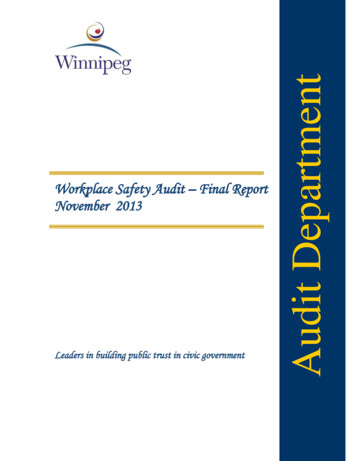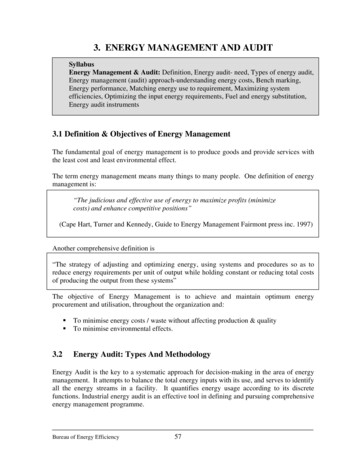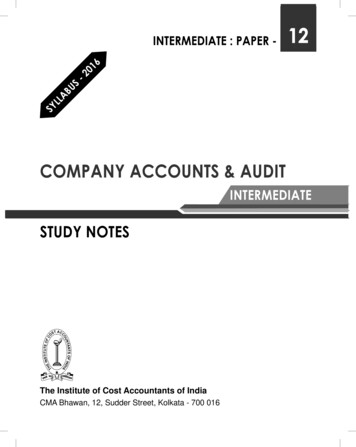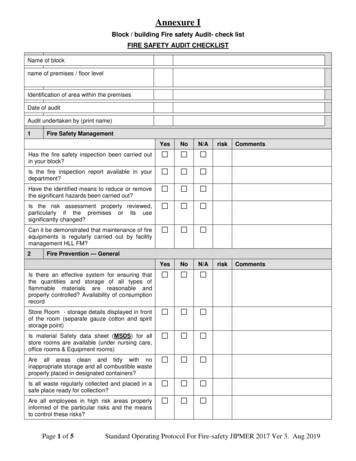
Transcription
Leaders in building public trust in civic governmentAudit DepartmentWorkplace Safety Audit – Final ReportNovember 2013
Table of ContentsReport Highlights .3Mandate of the City Auditor.3Audit Background .4Audit Objectives .4Audit Approach .4Independence .5Audit Scope .5Audit Conclusions.5Acknowledgement.6Background .7Key Risks .8Performance Analysis .8Observations and Recommendations . 12GOVERNANCE STRUCTURE . 12MINIMUM ACCEPTABLE SAFETY STANDARDS . 13OVERSIGHT ROLES . 15REVIEW OF SAFETY PROGRAM . 20SAFETY ISSUE ESCALATION PROCEDURE . 21POLICIES AND PROCEDURES . 21TRAINING . 24DOCUMENTATION OF COMPLIANCE MONITORING . 27PERFORMANCE INFORMATION AND MANAGEMENT . 28Appendix 1 - Audit Process . 31Appendix 2 - Summary of Recommendations. 32Workplace Safety Audit – Final Report2
REPORT HIGHLIGHTSA primary focus of the City’s workplace safety program has been on reducing Loss Time Injuries(LTI) by 25% since it was highlighted as an area of focus in 2009. The City’s LTI rate hasremained stable over this period and the targeted decrease has not occurred despite the City’sefforts to address this issue. In 2012, safety related incidents accounted for 103,790 hours lostand 9.0 million in Workers Compensation related costs, an increase of 32% in one year. Whilethe City at both the organizational level and departmental level have developed andimplemented components of a comprehensive safety program, we believe that there are areasthat can be enhanced to support the achievement of the City’s ultimate goal which is aworkplace free from injuries.The Administrative Standard HR-010 Organizational Safety Governance (AdministrativeStandard HR-010) provides the governance framework for the workplace safety program for theCity. However, the roles and responsibilities outlined in the Administrative Standard HR-010 andthe protocols and procedures need to be better communicated and a complete set of minimumsafety standards needs to be established. These minimum safety standards should addressqualifications, training and the monitoring and reporting of compliance with the Act.The oversight role, at both the organizational and departmental level, needs to be expandedand strengthened to ensure the established minimum safety standards are being met. Systems,practices and controls need to be further developed to achieve the workplace safety goals ofreducing and ultimately eliminating workplace injuries and ensuring the City is in compliancewith Workplace Safety and Health Act (the Act).The current performance information is not adequate to monitor the City’s compliance with theWorkplace Safety and Health Act and effectiveness of the organizational and departmentalsafety programs. The current reporting primarily focuses on Loss Time Injuries, which is only asmall component of a workplace safety program. In order to properly monitor the progress andeffectiveness of a safety program the performance information reported should include thenumber of near misses, the percentage of corrective actions that have been implemented andthe level of compliance with training standards (i.e. percentage of Safety Committee membersthat meet minimum training requirements). In order ensure the integrity of this information thecurrent performance management systems need to be further developed to ensure informationcollected and reported is complete, relevant, accurate, and meaningful. This will assist in theongoing and proactive management of a workplace safety program at both the organization anddepartment level and monitoring of the City’s progress towards meeting the minimum safetystandards.MANDATE OF THE CITY AUDITORThe City Auditor is a statutory officer appointed by City Council under The City of WinnipegCharter. The City Auditor reports to Council through the Audit Committee (the Executive PolicyCommittee) and is independent of the City’s Public Service. The City Auditor conductsexaminations of the operations of the City and its affiliated bodies to assist Council in itsgovernance role of ensuring the Public Service’s accountability for the quality of stewardshipover public funds and for the achievement of value for money in City operations. Once an auditreport has been communicated to Council, it becomes a public document.Workplace Safety Audit – Final Report3
AUDIT BACKGROUNDIn 2012, safety incidents accounted for 103,790 lost hours and 9.0 million in workerscompensation related costs. While the City has experienced stable Loss Time Injury (LTI)statistics for the past five years, the City’s LTI is significantly higher than the provincial averageand the province’s LTI has been on a decreasing trend. These factors prompted the Director ofCorporate Support Services to request an audit of workplace safety. An audit of the workplacesafety program was added to the City Auditor’s Audit Plan 2011-2014 in 2012 and wasendorsed by Audit Committee.AUDIT OBJECTIVESThe objectives of this audit were:1. To determine the effectiveness and efficiency of the workplace safety program at theorganizational and departmental level.2. To determine the adequacy and completeness of the workplace safety performanceinformation.AUDIT APPROACHWe conducted the audit in accordance with generally accepted auditing standards. Appendix 1provides a flowchart of the audit process. We conducted interviews with staff from the Organizational Safety and OccupationalHygiene Branch of Corporate Support Services, Corporate Support Services, CommunityServices, Fire Paramedic Service, Planning, Property and Development, Public Works,Water and Waste, Winnipeg Fleet Management Agency, Winnipeg Police Service andWinnipeg Transit to gain an understanding of the general workplace safety awareness andpractices throughout the City. We modeled our questions after the Safety and HealthProgram Assessment Tool, which is provided by the Province of Manitoba and designed asa model for employers to self-assess their workplace safety programs against what isrequired in the Workplace Safety and Health Act.We reviewed the Province of Manitoba Workplace Safety and Health Act (the Act) to gain anunderstanding of what the standards are for a workplace safety program to be in compliancewith the Act.We reviewed the Administrative Standard HR–010 Organizational Safety Governance,Administrative Standard HR-006 Safety, Health, and Organizational Wellness and theOrganizational Safety Code to gain an understanding of the governance structure andrespective responsibilities and authorities of key City staff with respect to workplace safety.We reviewed and tested a sample of incidents reported through PeopleSoft and reviewedthe related employee files to ensure sufficient documentation was on file to demonstrate therequirements of an effective workplace safety program.Workplace Safety Audit – Final Report4
We reviewed statistical information and performance reports regarding workplace safetyboth at the departmental level and the City level to assess if the information availableaccurate, complete, timely and sufficient to effectively and efficiently manage the workplacesafety program and provide the necessary oversight.Our conclusions are based upon information available at the time of the report. In the event thatsignificant information is brought to our attention after completion of the audit, we reserve theright to amend the conclusions reached.INDEPENDENCEThe team members selected for the audit did not have any conflicts of interest related to thesubject matter of the audit.AUDIT SCOPEOur audit is limited to the statistics, transactions, policies, procedures, manuals, bylaws, andlegislation related to workplace safety from the period of 2008 to 2012. Our focus is on thereview of workplace safety processes and practices currently in place in major departments andat the organizational level and the assessment of the progress of planned workplace safetyinitiatives. The City has other initiatives, such as Alcohol and Drug Free Workplace, RespectfulWorkplace and Employee Assistance Plan that target workplace health that were not included inthe scope of this review.AUDIT CONCLUSIONSThe audit work performed led us to the following conclusions:Overall, The City provides some useful standards, protocols and procedures at both theorganizational and departmental levels, but there are opportunities to improve. Establishedstandards and procedures need to be better communicated through the development of a set ofminimum acceptable safety standards. The oversight role, at both the organizational anddepartmental level, also needs to be strengthened. Systems, practices and controls need to befurther developed to achieve the workplace safety goals of reducing and ultimately eliminatingworkplace injuries and ensuring the City is in compliance with Workplace Safety and Health Act.The current performance information is not adequate to monitor the City’s compliance with theWorkplace Safety and Health Act or the effectiveness of the organizational and departmentalsafety programs. The performance information that is being collected and reported to seniormanagement is primarily Loss Time Injury statistics which presents a limited view of theworkplace safety program. Additional performance information, such as the number of all safetyincidents including near misses, the number of corrective actions implemented and the level ofcompliance with training standards needs to be collected and reported to the right people at theright time to properly manage the workplace safety program. The current safety performancemanagement systems need to be further developed to ensure information collected andreported is complete, relevant, accurate, and meaningful to assist in the ongoing and proactivemanagement of a workplace safety program at both the organization and department level.Workplace Safety Audit – Final Report5
ACKNOWLEDGEMENTThe Audit Department wants to extend its appreciation to all of the City departments whoparticipated in this audit and especially to the Organizational Safety and Occupational HygieneBranch of the Corporate Support Services Department’s staff for their time and cooperation.We would also like to acknowledge all the dedicated and enthusiastic safety personnel at theorganization and department level who participated in this audit. Their commitment tocontinuously improving workplace safety was evident throughout the audit.The Audit TeamBryan Mansky, MBA, CMA, CIADeputy City AuditorJason Egert, CA,CIAProject LeaderLarissa Klimchak, CMA, CIAAuditorDonovan Fontaine, CA, CIAAuditorNovember, 2013Brian Whiteside, CA, CIACity AuditorDateWorkplace Safety Audit – Final Report6
BACKGROUNDIn 2009, the CAO at the time gave clear direction to focus on reducing Loss Time Injuries (LTI) by 25%.The decrease has not occurred despite the City’s efforts to address this issue. In 2012, safety relatedincidents accounted for 103,790 hours lost and 9.0 million in Workers Compensation related costs a32% increase in costs in one year.The Workplace Safety and Health Act (the Act) is the Provincial legislation that governs the City’sworkplace safety program which outlines clear criteria on what is expected of a workplace safetyprogram. The Province provides guidance and tools to assist employers in establishing robust safetyprograms through their Safe Work website and supporting materials. The Province ensures allemployers operate within the guidance set by the Workplace Safety and Health Act by monitoringcompliance and imposing fines where organizations are found to have significant deficiencies.The general objective of the Workplace Safety and Health Act is to protect workers, self-employedpersons and others from risks to their safety, health and welfare arising out of, or in connection with,activities in their workplaces. Employers must provide safe equipment, a safe working environment,adequate supervision, information and training. Managers, supervisors and workers have aresponsibility to help the employer carry out these responsibilities.Since employers have the greatest degree of control over the workplace, they also have the greatestdegree of legal responsibility for safety and health. In 2004, Bill C-45 made it possible to holdemployers and their leaders (which includes anyone who is in charge of other employees) criminallynegligent.To address the requirements of the Workplace Safety and Health Act and to ensure the City is in fact asafe place to work, the City has established a workplace safety program at both the organizational leveland the departmental level. The City’s safety statement emphasizes that safety is a top priority andrequires active participation from everyone. The City’s ultimate goal is “A workplace free of accidents,injuries and occupational illness.”The Corporate Support Services Department established Administrative Standard HR-010 whichoutlines the organizational safety governance model at the City. The Organizational Safety Code ofPractice provides more detailed guidance on roles and responsibilities for all employees, as well ashigh level procedures for raising safety concerns, reporting incidents and addressing unsafe acts. Theorganization has also established City-wide protocols in key safety program areas, such as workplaceincidents, workplace inspections, contractor safety and chemical safety. Each department hassupplemented these documents with their own procedures and practices. The majority of these are inthe form of site specific risk assessments, job hazard analysis and safe work procedures. Theseprovide workers with instruction on how to perform their duties or handle hazardous material in a safemanner.Workplace Safety Audit – Final Report7
KEY RISKSThe potential key risks associated with Workplace Safety include:Compliance Non-compliance with the Workplace Safety and Health Act (MB) Non–compliance with the Workers Compensation Board Act Non-compliance with Union AgreementsOrganizational Culture Lack of policies and guidelines to properly direct workplace safety Lack of clear accountability/responsibility Workplace safety not taken seriously Unsafe work practices encouraged to save time/ moneyBusiness Process Not proactive in addressing workplace safety issues Lack of central coordination of workplace safety issuesHuman Resources Insufficient staff Inadequately trained staffFinancial Resources Inadequate funding to adequately address workplace safety issuesInformation Resources Insufficient performance information to be able to effectively manage the workplace safetyprocessesPhysical Assets Improper equipmentThe above noted potential risks and the processes in place to manage them were considered duringthe conduct of our audit.PERFORMANCE ANALYSISPerformance information provides the foundation to understand if the systems and processes arefunctioning as intended and achieving the desired results. A safety performance information systemshould provide senior management with a comprehensive overview of the City’s safety program. Itshould also provide departmental safety resources with information specific to their department toassist in identifying where systems are working well and areas for further evaluation.The workplace safety information that is prepared and presented annually to the City’s seniormanagement team in the Organizational Safety Performance Report is primarily loss time injurystatistics. Departmentally, the safety performance information varies greatly in terms ofcomprehensiveness and the level of detail and analysis performed on the information.Workplace Safety Audit – Final Report8
The following section will provide an overview of the performance information that we were able toobtain on a city-wide basis. We further discuss the need for a comprehensive set of performancemeasures in the Observations & Recommendation section of the report.Loss Time Injury (LTI) FrequencyLTI frequency is the number of lost time injuries per 100 workers per year. It can be used as an internalbenchmark to determine if progress has been made within an organization to reduce the occurrence ofinjuries. Figure 1 illustrates that theCity’s LTI frequency was 7.4 in 2012(5.3 as calculated by WorkersCompensation Board 1) and has beenrelatively stable over the period from2008 to 2012. The City’s target in 2010was a 25% reduction in LTI and despiteincreased efforts and theimplementation of departmental injuryreduction plans, the City has not seen adecrease in this indicator. This is incontrast to the LTI frequency rate forthe Province of Manitoba (3.3) ascalculated by Workers CompensationBoard1 which was significantly (38%)lower and on a decreasing trend.In Figure 2, the City’s LTI frequency statistics are further broken down by department. The LTIfrequency has fluctuated over this period for most departments.Note: only includes departments with LTI Frequency consistently greater than zero.Note: Organization refers to City of Winnipeg Average1Workers Compensation Board (WCB) uses gross payroll information to calculate LTI which includes periods when an employee is notpresent in the workplace (i.e. vacation, sick time, etc.). The City does not include this in their LTI calculations to improve the accuracy.Workplace Safety Audit – Final Report9
LTI SeverityLTI severity reflects the seriousness of an injury and also the effectiveness of return to work anddisability management programs. Severity is measured as hours lost due to injury per 100 workers peryear and includes any hours lost in a given year regardless of the year of injury. The City experiencedan increase of 24% in 2012 compared to 2011, which followed a 30% increase in 2011. Prior to 2011,the City had been trending downwards(Figure 3). Taken together the LTIFrequency and Severity is highlightingthat even though the number of injuries isrelatively stable, in 2011 and 2012 theseinjuries resulted in longer absences fromthe workplace. This translates into highercosts to the City in both lost time andhigher rehabilitative costs.This was broken down further bydepartment in Figure 4. Similar to the LTIfrequency data, the LTI severity hasfluctuated for every department. In total,103,790 hours have been lost to injuries in 2012, which translates to 49.9 full time staff (based on a 40hour work week). Clearly this is a significant issue for the City and must be addressed.Note: only includes departments with LTI Severity consistently greater than zero.Note: Organization refers to City of Winnipeg AverageNature of InjuryIn addition to the LTI data, both at the organization level and the department level incidents areanalyzed by the nature of injury. This helps identify what are the most frequent types of injuries that arecausing LTIs. This information enables departments to focus their efforts on areas of concern andallows the Organizational Safety Branch to monitor trends across the City. As Figure 5 illustrates themost predominant injury that led to time loss in 2011 was strains and sprains, accounting for 67% of allWorkplace Safety Audit – Final Report10
loss time injuries. To address this issue the Organizational Safety Branch, with input from thedepartments, initiated a project (Body@Work) in May of 2012 in partnership with the WCB. The goal ofthe project is to reduce workers’ compensation claims and extended absences associated with strainsand sprains. It is too early to evaluate the success of this program.Workers Compensation CostsThe comprehensive cost of workplace safety related incidents is currently not being tracked or reported.Workers Compensations Board (WCB) related costs, such as compensation for direct hours lost,rehabilitation costs, WCB claim administration costs are tracked by the Workers Compensation Branch,Risk Management Division of theCorporate Finance Department.Figure 6 shows that WCB relatedcosts have increased from 6.8million in 2011 to 9.0 million in2012, an increase of 32%. This isdue to the increased cost ofrehabilitation and increases in salaryrelated expenses. The WCB figureonly represents the basic costsassociated directly with the claim anddoes not include costs such aswages to backfill the position, ifnecessary, or reduced productivityonce the person returns to work. Although the City does not have a complete cost figure, the WCBWorkplace Safety Audit – Final Report11
costs are already significant and trending in the wrong direction highlighting the need for the City totake proactive measures to reduce safety related incidents in the workplace.OBSERVATIONS AND RECOMMENDATIONSA complete summary of the recommendations is attached as Appendix 2.GOVERNANCE STRUCTUREAdministrative Standard HR-010 Organizational Safety Governance’s (Administrative Standard HR010) purpose is to ensure workplace safety is managed at the highest levels within the City andestablishes the structure for strategic decision-making and direction setting for safety at the City.The Administrative Standard HR-010 clearly outlines the roles and responsibilities of all levels, from theChief Administrative Officer (CAO) to Departmental Safety Resources. It also states that it is to alignwith Administrative Standard IS-001 Governance Structure – Internal Services 1 which in part outlinesthe key roles and responsibilities and authorities within Human Resources which is where WorkplaceSafety reports to in all but a few departments 2. Under the current structure the Human ResourceLeaders have a dual reporting relationship; they have a solid line relationship to the Director ofCorporate Support Services (Director of CSS) and a dotted line to the Director of the department wherethey provide service.The CAO assumes overall responsibility for safety within the organization under the AdministrativeStandard HR-010. The Chief Operating Officer (COO) holds the Director of CSS accountable fororganizational safety initiatives and Departmental Directors are accountable for the implementation ofsafety programs within their department. In order to assist the Director of Corporate Services in fulfillingtheir responsibilities, the Organizational Safety and Occupational Hygiene Branch (OrganizationalSafety Branch) and the Departmental Human Resources Leaders provide the Director of CSS withinformation required to evaluate the progress of organizational safety initiatives. The departmentalHuman Resource Leaders are supported by the Departmental Safety Resources in the fulfillment oftheir responsibilities.From a governance perspective the City has guidance in place that is consistent with the requirementsstated under the Workplace Safety and Health Act (the Act). The Administrative Standard HR-010provides guidance with respect to the responsibilities of all levels of City employees concerningworkplace safety.However, from our interviews it appears that even though the responsibilities of all levels of Cityemployees have been defined in the Administrative Standard HR-010, some responsibilities have notbeen consistently interpreted. In particular, there exists some misunderstanding of what is a “must do”versus a “may do” with respect to implementing corporate initiatives, in particular around oversightpractices. We believe these misunderstandings are in part due to a need to better define expectationsfor the oversight role through the development of a more comprehensive set of minimum safetystandards, which will be discussed in more depth in the Minimum Acceptable Safety Standards section1Service Level Agreement for internal services has not been developed for the Winnipeg Police Service. WPS Human Resource Leader hasan indirect (i.e. dotted line) reporting relationship to the Director of CSS.2Fire Paramedic Service and Fleet Management Services report internally within their departmentWorkplace Safety Audit – Final Report12
of the report. We believe a renewed communication effort will address any current misunderstandingsand ensure all roles and responsibilities are clearly understood moving forward. The role of thecorporate group is to lead, coordinate and/or facilitate organizational safety initiatives that affectmultiple departments to monitor compliance with the Act. The role of human resource leaders anddepartmental safety staff is to ensure those initiatives are effectively and efficiently implemented tomaintain compliance but also to reflect the unique operations performed by different departments. Asthe governance model for safety is communicated to departments it may be necessary for refinementsto be made to the current Administrative Standard HR-010 to address any misunderstandings that maybe highlighted during this outreach to organizational and departmental leaders.Recommendation 1Director of CSS should ensure Administrative Standard HR-010 is re-communicated to all organizationand departmental leaders with emphasis on the respective roles and responsibilities and furtherdefining the expectations for oversight.Management ResponseAgree. To ensure consistent interpretation of responsibilities as outlined in Administrative Standard HR010, expectations for oversight must be clarified. This can be accomplished through establishment andcommunication of minimum standards for safety performance measurement and reporting (seeresponse to Recommendation #2). Timeline: Second quarter 2014MINIMUM ACCEPTABLE SAFETY STANDARDSSetting minimum safety standards is essential to building a safe work environment. Standards help tobuild a positive culture, control the risks and set out how City employees will perform their work. Theyshould identify who does what, when and the expected result. 1 Standards must be: measurable,achievable and realistic.Administrative Standard HR-010 identifies the Director of CSS as being accountable for organizationalsafety initiatives and to approve the implementation of any necessary changes in overall direction,plans and/or standards as they relate to organizational safety. We interpret this to mean that theDirector of Corporate Support Services has the responsibility to monitor the City’s compliance with theWorkplace Safety and Health Act. This translates into identifying minimum acceptable safety standardsfor the performance of work, some of which have already been developed and others that still need tobe developed.The following standard practices have been adopted at the organizational level: How to raise safety concerns Escalation of safety concerns Reporting an incident or injury Incident investigation Safety inspections Contractor safety procedures Chemical safety Job Hazard Analysis and Safe Work Procedures1Managing Health and Safety: Five Steps to Success, Health and Safety Executive, Government of UKWorkplace Safety Audit – Final Report13
The following standard practices need to be developed the organizational level: Training for supervisory staff Safety Orientations/ Job Related Training Qualifications for safety resources Qualifications for safety committees Monitoring compliance Performance reporting Review of safety programThese safety standards should be consistently documented, clearly communicated and implemented inall departments. The progress towards the full implementation of these standards should be periodicallymonitored by the Organizational Safety and Occupational Hygiene Branch and reported to the Directorof Corporate Support Services.Through our audit work we identified differing practices and standards with respect to safety programsin the departments. From a perspective of minimum safety standards, there should be no deviation. If adepartment chooses to exceed minimum standard, they may do so if the departmental director issupportive. Once the minimum safety standards are communicated to the dep
workplace free from injuries. The Administrative StandardHR-010 Organizational Safety Governance (Administrative Standard HR-010) provides the governance framework for the workplace safety program for the City. However, the roles and responsibilities outlined in the Administrative Standard HR010- and










